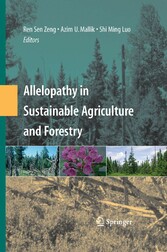Search and Find
Service
"4. Allelochemicals in Plants (p. 63-64)
Terry Haig
E.H. Graham Center for Agricultural Innovation, Charles Sturt University, Wagga Wagga, Australia. thaig@csu.edu.au
Abstract. This chapter presents a brief coverage of a range of common plant allelochemical groups, and includes discussion of their structures, chemistry, distribution, ecology, bioactivity, biosynthesis, allelopathy, and mode of action where known.
4.1 Introduction
Allelochemicals are non-nutritional secondary metabolites produced by living organisms (i.e., plants) that have stimulatory or inhibitory effects upon the growth, health, behavior, or population biology of neighboring organisms (plants, insects, microbes, etc.). In plant–plant allelopathy, the more common inhibitor effects are visible upon such plant functions as respiration, photosynthesis, water balance and stomatal function, stem conductance of water, xylem element flux, membrane permeability, cell division and development, protein synthesis, and enzyme activity alteration. Within plants, allelochemicals may be distributed broadly among organs such as seeds, flowers, pollen, leaves, stems, and roots, or sometimes found in just one or two such locations. Their kingdom distribution is rather specific, with a particular class of allelochemical being often found confined to a limited range of plant families or genera, for example, the sesquiterpene lactones found in the Asteraceae.
When released from plants, a potential allelopathic compound may first have to undergo some metabolic or environmental alteration in structure before it assumes biological activity. Alternatively, some bioactive compounds released from a plant may be rendered inactive by subsequent chemical transformations in the air, water, or soil. Allelochemicals exist in a vast array of seemingly disconnected structures and possess widely different modes of action. Not many of these modes of action are completely understood, but of those known, it appears that they can be quite divergent from the 30 or so presently known activity modes associated with artificial herbicides. The role played by allelochemicals is mostly interpreted now in an ecological way, usually in some means of plant defense against other plants, pests, or diseases. The standard modes of release for allelochemicals are volatilization, residue decay, leaching, or root exudation. Such exudation has been somewhat overlooked in the past history of allelopathic science, with most attention devoted to the more visible, above-ground aspects of plants.
However, the central significance of underground communication and transfer between neighboring plants has received more attention and doubtless will give rise to new endeavors to elucidate allelopathic chemistry and mechanism (Bais et al. 2001). Laboratory bioassays for phytotoxicity/allelopathy are becoming more standardized so that effective comparisons can be made between the allelopathic potentials of different plants (Belz and Hurle 2004). A cautionary comment upon the use of the word ""allelochemical"" is also warranted. Strictly speaking, this term should really only be applied to those substances whose combat role between donor and receiver plants has been firmly established by quality experimental evidence (especially in genuine field circumstances), and not simply that a plant-derived compound shows toxicity toward some (perhaps irrelevant) other plant during in vitro bioassay."
All prices incl. VAT













